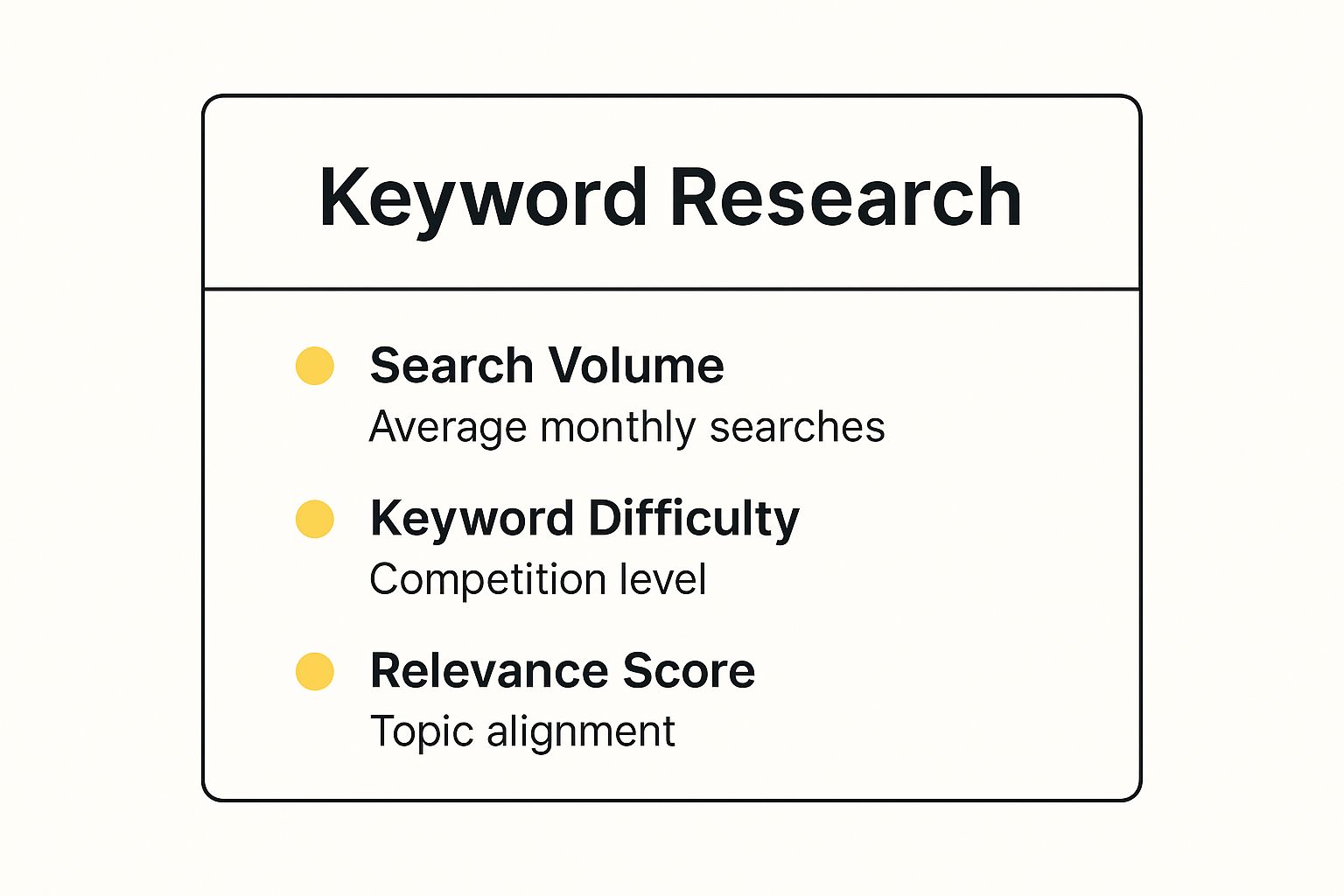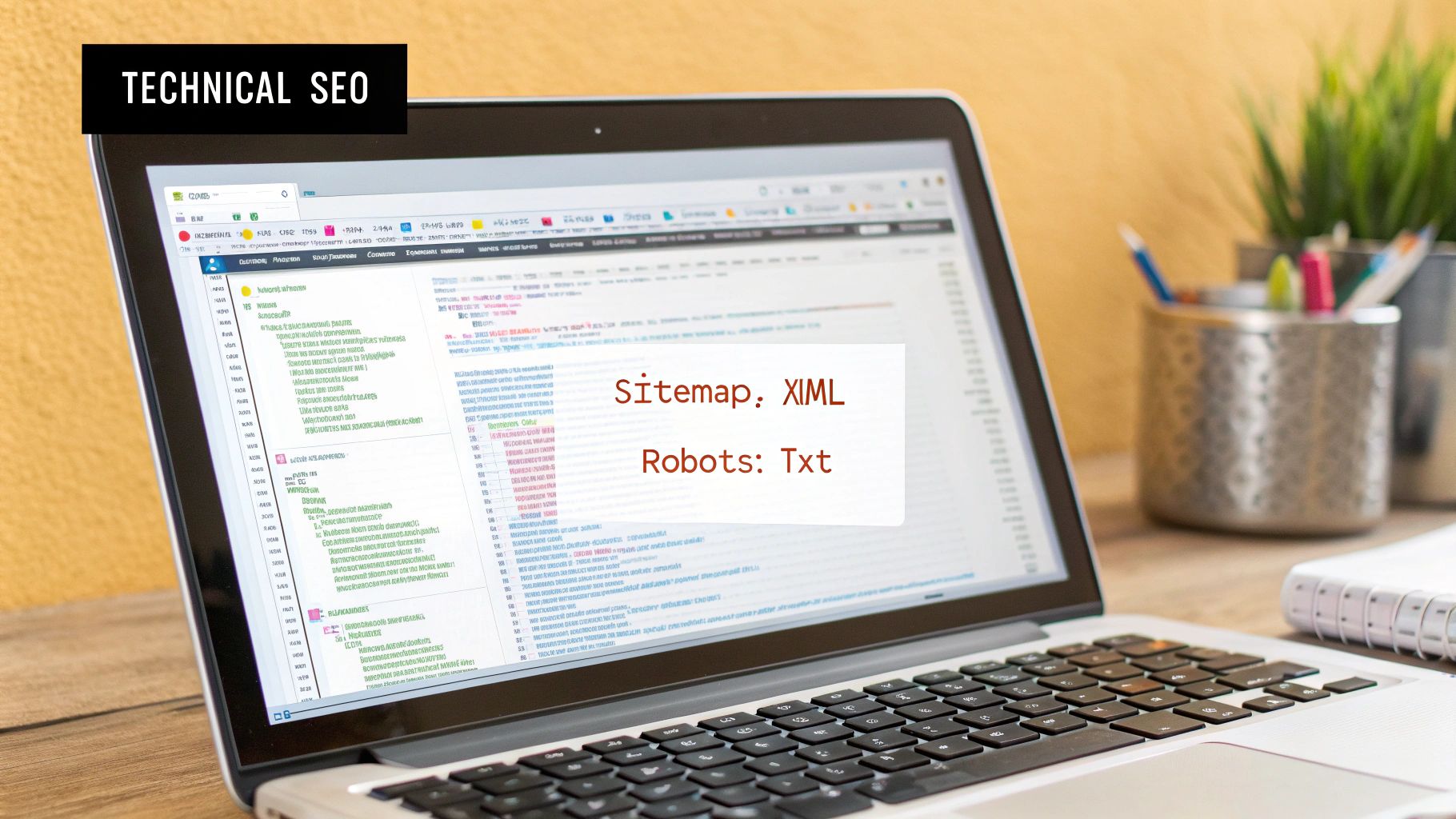To really get your website humming for search engines, you need to focus on four key areas that all work together: technical health, on-page elements, content strategy, and authority building. It's a balanced approach. If you nail these, you're not just chasing algorithms—you're building a solid foundation that brings in organic traffic for the long haul.
Building Your Foundation for Search Success
Figuring out how to optimize your website can feel like you're trying to solve a puzzle where the pieces keep changing. But here's the thing: real success isn't about jumping on every new trend. It's about building a rock-solid foundation that works for search engines and, more importantly, for the people visiting your site.
A winning strategy breaks down into a few core areas. Think of it like building a house. You need a solid foundation (technical SEO), strong walls and a good layout (on-page SEO), great furniture (content), and a good reputation in the neighborhood (authority signals). If any one of those is shaky, the whole thing is at risk.
The four pillars you really need to master are:
- Technical Health: This is the bedrock. It’s all about making sure search engines can find, crawl, and index your pages without a hitch. This covers things like site speed, mobile-friendliness, and a logical site structure.
- On-Page Elements: These are the tweaks you make directly on your website’s pages. We're talking about crafting compelling title tags, writing clear meta descriptions, using headings correctly, and optimizing images so search engines know what your content is all about.
- Content Strategy: This is the heart and soul of your SEO. It's about creating valuable, relevant stuff that answers your audience's questions and makes you look like the expert you are. Great content is what pulls people in and earns those valuable backlinks.
- Authority Signals: These are the external clues that tell search engines your site is trustworthy. The biggest one? Backlinks—links from other credible websites pointing to yours.
The infographic below gives you a nice visual of how metrics like search volume, competition, and relevance all have to work together in your content and keyword strategy.

This breakdown really shows the balancing act required to pick topics that are not only popular but also ones you can realistically rank for.
To give you a clearer picture of how these pillars support each other, here's a quick summary table.
Core Pillars of Website Optimization
This table breaks down the four key areas of SEO, outlining what each one aims to achieve and how it directly contributes to your site's performance in search results.
| SEO Pillar | Primary Goal | Key Actions | Impact on Ranking |
|---|---|---|---|
| Technical Health | Ensure search engines can easily access and index the site. | Site speed optimization, mobile-friendliness, XML sitemaps, robots.txt, schema markup. | High. A technically unsound site can be invisible to Google. |
| On-Page Elements | Help search engines understand the content and context of each page. | Keyword research, title tags, meta descriptions, header tags (H1, H2), image alt text. | High. Directly tells search engines what a page is about. |
| Content Strategy | Attract and engage the target audience by providing valuable information. | Creating blog posts, guides, videos, and tools that solve user problems and target keywords. | Very High. Quality content is the primary reason sites rank. |
| Authority Signals | Build trust and credibility with search engines and users. | Acquiring high-quality backlinks from reputable sites, managing online reviews, brand mentions. | Very High. External validation is a massive ranking factor. |
Mastering these four pillars ensures you're not leaving any gaps in your strategy. Each one builds on the others to create a powerful, sustainable SEO presence.
For anyone running an e-commerce store, a lot of these same principles apply, but with a few unique twists. If you're on that platform, you might want to check out this guide on how to improve Shopify SEO. It’s a proven path to getting sustainable results.
Mastering Your On-Page SEO Elements
Once your website's technical house is in order, it's time to zoom in on the stuff you can control on every single page. This is where the rubber meets the road—turning your keyword research into clear signals that tell search engines exactly what your content is all about. Good on-page SEO isn't just about stuffing keywords everywhere; it's about creating a smooth, logical experience for both people and search engine bots.
Think of your title tag and meta description as your webpage's billboard on Google. A killer title tag does more than just state the topic; it grabs attention and begs to be clicked. A compelling meta description acts like a tiny ad, quickly summarizing the value someone gets from visiting your page. In a crowded search results page, these are often your only shot at making a first impression.
Crafting Titles And Descriptions That Convert
Your title tag is probably the single most important on-page factor. Keep it concise—ideally 50-60 characters so it doesn't get cut off—and try to get your main keyword near the beginning. It needs to clearly tell people what they're about to see. A lazy title like "Our Services" gets ignored. A sharp, optimized title like "Data-Driven SEO Services for Omaha Businesses | Up North Media" gets the click.
While the meta description doesn't directly impact your rankings, it has a huge influence on your click-through rate (CTR). This little blurb (around 150-160 characters) should be an engaging summary that uses your target keyword and spells out a clear benefit. It has to answer the user's unspoken question: "Why should I click this one?"
Pro Tip: Write your titles and metas like you're writing ad copy. Use action-oriented language, highlight what makes you unique, and speak directly to what the user is looking for. A higher CTR is a strong signal to Google that your page is a good match, which can absolutely help your rankings over time.
Structuring Content With Smart Headings
Headings (H1, H2, H3) do more than just style your text. They build a logical hierarchy for your content, acting as a roadmap for both readers and search engines. This structure makes your articles scannable and way easier to digest, which is key to keeping people from bouncing off your page.
Here’s a simple way to think about it:
- H1 Tag: You only get one of these per page. It’s your main headline and should feature your primary keyword.
- H2 Tags: Use these to break your article into major sections. They're perfect spots for secondary keywords or different phrasings of your main one.
- H3 Tags: These are for sub-points within your H2 sections. They add another layer of organization and make complex topics easier to follow.
This example from Ahrefs shows how on-page elements work in harmony to signal relevance.

See how the target keyword is strategically placed in the title, URL, and the first paragraph? That creates a powerful, consistent message about what the page is about.
Optimizing Images and Internal Links
Big, clunky images are a classic site-killer. Always compress your images before uploading them to slash the file size without totally ruining the quality. Beyond that, give your images descriptive file names (like on-page-seo-elements.jpg instead of IMG_1234.jpg) and always use descriptive alt text. Alt text is crucial—it helps search engines understand the image and makes your site accessible to users with visual impairments.
Finally, don’t sleep on internal linking. It's a surprisingly powerful strategy that many people overlook. By linking to other relevant pages on your own site, you can:
- Help search engines crawl and discover more of your content.
- Spread "link equity" (or authority) throughout your website.
- Keep users engaged by guiding them to other helpful resources.
If you want to go deeper on these tactics, our guide on advanced search engine optimization techniques has more actionable strategies you can use today. Getting these on-page elements right is a fundamental step toward really mastering how to optimize a website for search engines.
Developing a Winning Content and Keyword Strategy

Alright, getting your technical and on-page SEO in order is like building a solid foundation for a house. It’s absolutely essential, but it’s not the house itself. Your content is what fills that house and turns it into a place people actually want to visit.
Without a smart content and keyword strategy, even the most technically flawless site is just an empty shell. This is your chance to connect directly with what your audience is searching for, answer their questions, and solve their problems.
At the heart of it all is user intent—the "why" behind every search. Is someone looking for information, trying to make a purchase, or comparing different options? If your content doesn't line up with their intent, you're not going to rank. It's that simple.
Uncovering What Your Audience Wants
Good keyword research isn't just about chasing terms with high search volume. It’s more like detective work, uncovering the specific questions and pain points of the people you want to reach. Your real goal is to become the best, most helpful answer they can find.
Start by brainstorming some broad "seed" keywords related to your business. If you’re a local Omaha marketing agency like us, that might be "SEO services" or "web design Omaha." But don't stop there. The real magic happens when you dig deeper.
- Long-tail keywords are your secret weapon. These are longer, more specific phrases like "SEO services for small businesses in Omaha." They signal much stronger intent, have less competition, and often lead to better conversions.
- Question-based keywords are pure gold for content ideas. Any phrase starting with "how to," "what is," or "why" is a direct line into your audience's head. It's a roadmap for creating blog posts that solve real problems.
- Competitor analysis is a must. See what keywords your competitors are ranking for. This can shine a light on opportunities you’ve missed and show you what kind of content is already working in your space.
Analyzing the SERP for Clues
Before you write a single word, do this one thing: Google your target keyword. Seriously. The search engine results page (SERP) is a cheat sheet telling you exactly what Google thinks is the best answer for that query.
Are the top results all step-by-step guides? List-based articles? Videos? Product pages? This analysis is critical because it reveals the dominant content format and user intent. Trying to rank a blog post for a keyword where Google clearly favors e-commerce pages is an uphill battle you probably won’t win.
Key Takeaway: The SERP removes the guesswork. It shows you the formats, angles, and level of detail that are already winning. Your job is to create something even better—more comprehensive, more helpful, or more up-to-date.
Of course, keyword selection is just one piece of the puzzle. To really succeed, you need to master comprehensive content optimization strategies to squeeze every bit of performance out of your content.
Building Authority with E-E-A-T
Google has gotten incredibly smart about identifying quality. They now prioritize content that demonstrates Experience, Expertise, Authoritativeness, and Trustworthiness (E-E-A-T). This just means your content has to be accurate, well-researched, and written by someone who actually knows what they're talking about.
Here's how to build E-E-A-T into your content:
- Cite reputable sources and data. Back up your claims. This shows you've done your homework and builds instant trust with your readers.
- Showcase your experience. Use real-world examples, case studies, or even personal stories. This adds a unique perspective that no one else can copy.
- Keep content updated. An article from three years ago might be full of outdated information. Regularly refreshing your content keeps it relevant and trustworthy.
This whole push for quality is tied directly to making users happy. And it works. Consider that organic search results account for about 94% of all clicks globally. The depth of your content also plays a massive role; some studies have found that articles over 3,000 words can get three times more traffic and far more shares and backlinks than shorter pieces. This is why a solid content plan is the true engine of any effort to optimize a website for search engines.
Performing a Technical SEO Health Check
If your on-page SEO and content are the engine, then technical SEO is the chassis, transmission, and electrical system that holds it all together. You can have the most powerful engine in the world, but without a solid technical foundation, you're not going anywhere. This is the behind-the-scenes work that ensures search engines can actually find, understand, and rank your brilliant content.
A lot of people get intimidated by the term "technical SEO," but you really don't need to be a developer to spot and fix the most common roadblocks. Running a regular health check is a non-negotiable part of getting a website to perform well in search.
Prioritizing Mobile Friendliness and Site Speed
These days, how your website performs on a phone is everything. Google uses mobile-first indexing, which is just a fancy way of saying it primarily looks at the mobile version of your site for ranking. If your site is a clunky, slow, hard-to-navigate mess on a phone, your rankings are going to suffer—on all devices.
Just as important is how fast your pages actually load. Site speed is a confirmed ranking factor, and for good reason. Slow sites just flat-out frustrate people. In fact, data shows the probability of a user bouncing skyrockets by 32% as page load time creeps from 1 to 3 seconds. Your goal should be to make your site feel snappy and responsive.
You can get a solid read on these metrics using Google's own tools:
- Google PageSpeed Insights: This tool gives you a performance score for both mobile and desktop and, more importantly, provides specific, actionable recommendations to improve it.
- Google Search Console: Check the "Core Web Vitals" report here. It tracks your site's performance over time using real-world user data and flags any pages that need a tune-up.
Making Your Site Easy to Crawl and Index
Before Google can rank your pages, its crawlers (often called "spiders") have to find and understand them first. Luckily, you can give them a little help. Think of it as handing search engines a map and a clear set of instructions for exploring your website.
An XML sitemap is basically a list of all the important URLs you want Google to know about. Submitting this file through Google Search Console is a direct way to tell Google, "Hey, these are my pages, please index them," even if they aren't perfectly linked internally.
Your robots.txt file does the opposite—it tells search engines which parts of your site they shouldn't crawl. This is super useful for blocking things like admin areas, thank-you pages, or internal search results. It helps you focus Google’s resources on your most valuable content.
Crucial Insight: Managing how search engines crawl your site is known as "crawl budget optimization." You want Google's bots spending their time on your high-value pages, not getting lost in low-priority sections.
This graphic from Google's own documentation shows what influences your site's crawl budget.

As you can see, a fast, popular site with fresh content actually encourages Google to crawl more often. It’s another reminder of how site speed and content strategy are all connected.
To help you get a handle on all this, I've put together a checklist of the core technical elements you should be reviewing regularly.
Technical SEO Audit Checklist
This table breaks down the essential technical elements you'll want to check. It covers what each element does, the tools you can use to analyze it, and why it matters for your overall SEO performance.
| Technical Element | What to Check | Recommended Tool | Importance Level |
|---|---|---|---|
| Mobile-Friendliness | Ensure the site displays correctly and is easy to use on mobile devices. Check for tap targets that are too close or text that's too small. | Google's Mobile-Friendly Test | Critical |
| Site Speed / Core Web Vitals | Analyze load times and user experience metrics (LCP, FID, CLS). Aim for a "Good" score across the board. | Google PageSpeed Insights | Critical |
| HTTPS Security | Verify that every page on your site uses HTTPS. Check for mixed content errors where insecure elements are loading on a secure page. | Your Browser's URL Bar | Critical |
| XML Sitemap | Confirm your sitemap exists, is error-free, and has been submitted to Google Search Console. It should only include indexable, canonical URLs. | Google Search Console | High |
| Robots.txt File | Check that your robots.txt file isn't accidentally blocking important CSS, JavaScript, or key content areas from being crawled. | Google's robots.txt Tester | High |
| Crawl Errors | Look for 404 "Not Found" errors or server errors (5xx) in the Coverage report. These prevent pages from being indexed. | Google Search Console | High |
| Duplicate Content | Use a site crawler to find instances of duplicate or very similar content, which can dilute ranking signals. Check for www vs. non-www and HTTP vs. HTTPS versions. | Screaming Frog or Ahrefs | Medium |
| Broken Links | Find and fix any internal or external links that point to non-existent pages. Broken links create a poor user experience and waste crawl budget. | Screaming Frog or Ahrefs | Medium |
Running through this checklist every few months will help you catch technical issues before they turn into major ranking problems.
Ensuring Your Site Is Secure
Finally, let's talk about security. This one is simple but absolutely critical. Your website must use HTTPS, which encrypts the connection between a user's browser and your server. Google has used this as a ranking signal for years because it protects user data and builds trust.
If your site is still on HTTP, visitors will likely see a "Not Secure" warning in their browser—a huge red flag. Getting an SSL certificate and migrating to HTTPS is a straightforward fix with a direct impact on user trust and your search performance. Ticking these technical boxes is a foundational step for any serious SEO strategy.
Weaving AI into Your SEO Workflow
Artificial Intelligence isn't some futuristic fantasy anymore. It’s a real tool that gives you a serious competitive edge in SEO, right now. Bringing AI into your daily tasks is all about working smarter, not harder. It automates the grunt work and digs up data-driven insights that used to be almost impossible to find.
This isn't just a fringe trend. A staggering 86% of SEO professionals have already woven AI into their strategies. Of those, 67% are using it specifically to automate routine tasks like keyword research and churning out meta tags. The proof is in the results, with 65% of businesses reporting better SEO outcomes after adding AI tools to their mix.
It's not just about saving time; it's about getting better results.
Automating Content Creation and Ideation
One of the most immediate wins with AI is in content development. Generative AI platforms are fantastic creative partners for brainstorming blog topics, outlining complex articles, and even drafting meta descriptions at scale.
For example, you could feed an AI tool a core topic like "technical SEO for e-commerce" and ask for a list of long-tail keywords, common questions people ask, and a few different article outlines. A task that used to eat up hours of manual research can now be knocked out in minutes.
Key Takeaway: The goal isn't for AI to replace you. It's to make you better. Let AI do the initial heavy lifting—the brainstorming, structuring, and repetitive drafting—so you can spend your time adding unique insights, personal experience, and strategic direction. That’s the stuff that actually matters.
This frees you up to focus on high-impact work, like deep analysis and fine-tuning your strategy. For a closer look at how this works in practice, check out our guide on how AI is showing up in SEO and LLMs.
Uncovering Deeper Analytical Insights
Beyond just writing, AI is a beast at chewing through massive datasets to spot patterns a human might easily miss. Modern AI-powered SEO platforms can sift through competitor data, search trends, and performance metrics to spit out genuinely actionable recommendations.
These tools can help you:
- Spot Keyword Gaps: Pinpoint valuable keywords your competitors are ranking for that you’ve completely missed.
- Predict Search Trends: Analyze market data to forecast emerging topics and seasonal interest, letting you create timely content that hits just right.
- Monitor Competitor Moves: Get real-time alerts when your top rivals publish new content, snag a big backlink, or make a jump in the rankings.
This level of analysis shifts you from being reactive to proactive. Instead of just responding to what the competition does, you can start anticipating it. That's a huge advantage when you're figuring out how to optimize a website for search engines.
Choosing the Right AI Tools for Your Needs
The market is flooded with AI tools promising to make your SEO life easier. To really streamline your efforts, it’s worth exploring some of the Top 9 AI Marketing Software options that cover everything from content creation to analytics.
When you're picking a tool, focus on what will solve your biggest headaches. Is it speeding up content production? Or is it getting a clearer picture of the competitive landscape? By thoughtfully bringing AI into your process, you can transform your workflow from a series of manual chores into a strategic, data-informed operation.
Measuring Your SEO Impact and Refining Your Strategy
SEO isn't a "set it and forget it" kind of deal. Far from it. It's a constant cycle: you make changes, measure what happens, and then tweak your approach based on what the data tells you. Without that feedback loop, you're just guessing—you have no real way of knowing which efforts are actually bringing in traffic and which are just spinning wheels.
The goal is to shift from guesswork to data-driven decisions. This means getting friendly with two of the most important (and free) tools in the game: Google Analytics 4 (GA4) and Google Search Console (GSC). Think of them as your dashboard for understanding exactly how people find and use your site.
Tracking the Metrics That Matter
Instead of drowning in a sea of data, you need to zero in on a few Key Performance Indicators (KPIs) that give you a clear picture of your SEO health. These are the numbers that truly tell the story.
- Organic Traffic: This is the big one. It's the total number of people landing on your site from a search engine. A steady increase here is your top-level sign that things are working.
- Keyword Rankings: Where do your pages show up when someone searches for a specific term? Tracking this tells you if your content is actually gaining visibility for the keywords you're targeting.
- Click-Through Rate (CTR): This is the percentage of people who see your page in the search results and actually click on it. A low CTR can be a red flag that your title tags and meta descriptions aren't compelling enough to grab attention.
- Conversions: This is the ultimate goal, right? A conversion could be anything from a product sale to a contact form submission, all stemming from organic search.
For instance, this Google Analytics report gives you a clean breakdown of where your traffic is coming from. Keeping an eye on the "Organic Search" channel is crucial.
Watching these channels helps you figure out which of your marketing efforts are giving you the best bang for your buck.
Turning Data into Actionable Insights
The real magic isn't just watching these numbers—it's using them to make smarter moves.
See a page with tons of impressions but a pathetic CTR? That’s your cue to rewrite its title tag to be more enticing. Got a blog post pulling in lots of traffic but generating zero leads? Maybe the call-to-action is buried or unclear. Every piece of data is a clue.
Pro Tip: Dive into Google Search Console and hunt for "striking distance" keywords. These are queries where you're already ranking on the second page (positions 11-20). These pages are so close to hitting the big time. Often, all they need is a content refresh or a few more internal links to vault them onto page one, which can lead to a serious traffic spike.
This continuous cycle of analyzing and refining is what separates a flimsy SEO strategy from a sustainable one. To keep yourself organized, it helps to follow a structured guide like an SEO best practices checklist to make sure you're consistently hitting all the right notes.
Learning SEO is a journey of constant improvement, not a one-and-done project.
Got Questions About Website Optimization? We've Got Answers.
Even with a solid plan, a few common questions always pop up when you're digging into SEO. Let's clear the air on some of the big ones so you can stay focused on what actually moves the needle.
How Long Does It Take To See SEO Results?
This is the big one, isn't it? The honest answer is that SEO is a long game, not a quick win. While you might see some small flickers of movement in a few weeks, it realistically takes 4 to 6 months to see significant, lasting results.
Think of it like building a reputation. You're proving to search engines that you're a trustworthy source of information, and that just doesn't happen overnight. The timeline really depends on where you're starting from, how tough your industry's competition is, and how consistently you're putting in the work.
SEO is a marathon, not a sprint. The initial effort builds momentum, and consistent work over several months is what leads to lasting improvements in traffic and rankings. Don't get discouraged by a slow start.
What's The Difference Between On-Page And Off-Page SEO?
It’s simpler than it sounds.
Think of on-page SEO as everything you do on your own website. This is your turf. You’re in full control of things like optimizing title tags, writing high-quality content, adding internal links, and making sure your site is fast.
Off-page SEO, on the other hand, covers all the actions taken off your website to boost your authority. The main event here is link building—getting other reputable websites to link to yours. It’s like a vote of confidence from a trusted source, telling search engines you’re the real deal.
Do I Need To Be A Technical Expert?
Not at all. While some parts of technical SEO can get pretty deep, a huge chunk of what drives results is surprisingly accessible.
Honestly, you can get massive wins just by focusing on creating genuinely helpful content and nailing your on-page fundamentals. And with so many user-friendly tools available today, much of the technical heavy lifting is handled for you. You can make a serious impact without ever looking at a line of code.
Ready to stop guessing and start seeing real results from your SEO efforts? The team at Up North Media specializes in data-driven strategies that increase traffic and boost revenue. Schedule your free consultation today and let's build a plan to help you dominate your market.
